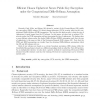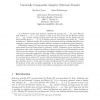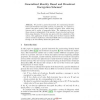ASIACRYPT
2008
Springer
15 years 2 months ago
2008
Springer
Abstract. In secure computation among a set P of players one considers an adversary who can corrupt certain players. The three usually considered types of corruption are active, pa...
93
Voted
ASIACRYPT
2008
Springer
15 years 2 months ago
2008
Springer
114
Voted
ASIACRYPT
2008
Springer
15 years 2 months ago
2008
Springer
Encryption schemes that support computation on encrypted data are useful in constructing efficient and intuitively simple cryptographic protocols. However, the approach was previo...
153
click to vote
ASIACRYPT
2008
Springer
15 years 2 months ago
2008
Springer
Recently Cash, Kiltz, and Shoup [20] showed a variant of the Cramer-Shoup (CS) public key encryption (PKE) scheme [21] whose chosen-ciphertext (CCA) security relies on the computa...
116
Voted
ASIACRYPT
2008
Springer
15 years 2 months ago
2008
Springer
In this paper, we show that two variants of Stern's identification scheme [IEEE Transaction on Information Theory '96] are provably secure against concurrent attack unde...
103
click to vote
ASIACRYPT
2008
Springer
15 years 2 months ago
2008
Springer
The collision-resistance of hash functions is an important foundation of many cryptographic protocols. Formally, collision-resistance can only be expected if the hash function in f...
111
click to vote
ASIACRYPT
2008
Springer
15 years 2 months ago
2008
Springer
Every public-key encryption scheme has to incorporate a certain amount of randomness into its ciphertexts to provide semantic security against chosen ciphertext attacks (IND-CCA). ...
112
click to vote
ASIACRYPT
2008
Springer
15 years 2 months ago
2008
Springer
In an oblivious transfer (OT) protocol, a Sender with messages M1, . . . , MN and a Receiver with indices 1, . . . , k [1, N] interact in such a way that at the end the Receiver ...
115
click to vote
ASIACRYPT
2008
Springer
15 years 2 months ago
2008
Springer
We study the security of the widely deployed Secure Session Layer/Transport Layer Security (TLS) key agreement protocol. Our analysis identifies, justifies, and exploits the modul...
116
Voted
ASIACRYPT
2008
Springer
15 years 2 months ago
2008
Springer
Abstract. We provide a general framework for constructing identitybased and broadcast encryption systems. In particular, we construct a general encryption system called spatial enc...





